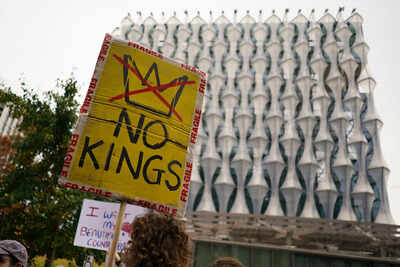Explained: What the ‘No Kings’ protests are and what students need to know about millions marching against Trump

In what could become one of the largest single days of protest in United States history, millions of Americans are gathering under a simple banner, No Kings. The slogan, drawn from the nation’s founding ideals, has turned into a nationwide movement against what many see as a drift towards authoritarianism under President Donald Trump’s administration.According to The Guardian, more than 2,500 events are planned across all 50 states, from major cities such as Washington, D.C., and New York to small towns across the Midwest. The coordinated demonstrations follow months of escalating tensions between the White House and opposition groups, and arrive amid a government shutdown that has stalled billions of dollars in federal funding.
Origins of the ‘No Kings’ movement
The No Kings coalition first gained visibility during a nationwide protest day in June, when millions took to the streets to oppose the administration’s use of federal forces in U.S. cities. This latest call to action, again coordinated by a network of progressive organizations, unions, and civil rights groups, expands that effort into a show of collective defiance.Organizers, as reported by The Guardian, describe the movement as “pro-democracy and pro-worker,” emphasizing the idea that American power rests with its citizens, not with “kings.” The protests seek to highlight concerns about what they call “authoritarian excesses” — including aggressive deportation policies, healthcare cuts, and efforts to override judicial and legislative limits on executive power.
A nationwide demonstration of scale
Events are scheduled from Honolulu to Boston, with each community organizing its own rally rather than converging on a single central site. This distributed structure is meant to illustrate how dissent is not confined to metropolitan areas but embedded across the country.The No Kings coalition’s platform calls on participants to wear yellow, a color associated with global pro-democracy movements in Ukraine, Hong Kong, and South Korea, to create a visible, unified symbol of resistance.Crowd estimates from Harvard University’s Crowd Counting Consortium suggest that the June No Kings protests drew between two and nearly five million participants, making them one of the largest demonstrations since the 2017 Women’s March. Organizers now expect even higher numbers, potentially surpassing that record.
The 3.5% rule and the power of participation
The coalition’s strategy draws inspiration from a concept known as the “3.5% rule,” developed by political scientists Erica Chenoweth and Maria Stephan. Their research on global civil resistance movements found that when roughly 3.5% of a population engages in sustained, non-violent protest, regimes almost always change course or collapse.While the United States has not yet reached that proportion — equivalent to about 11 million people — The Guardian reports that the movement’s organizers see the principle as motivational rather than prescriptive. Their aim is to build sustained civic participation rather than a single day of outrage.
Responses from Washington
The Trump administration has not directly commented on the 18 October protests. However, Republican leaders have criticized the demonstrations, portraying them as partisan disruptions that could prolong the budget impasse.Some cabinet officials, have suggested without evidence that protesters are being paid or that Democrats are leveraging the rallies for political advantage. Movement organizers have dismissed those claims, arguing that the protests represent a “visible, lawful rejection” of what they see as authoritarian tendencies, The Guardian reports.
Security and non-violence
Amid heightened political polarization, safety remains a central focus. Governors in several states, including Texas, have deployed National Guard troops, while federal officials have pledged to maintain law enforcement presence near protest sites.The No Kings coalition emphasizes non-violence as a guiding principle. Local organizers have trained marshals and distributed “know your rights” materials to participants. Tens of thousands have joined online safety briefings in preparation, according to The Guardian.
A test of democracy’s foundations
The No Kings protests are not merely about policy disagreements. They are about political culture — about whether American democracy, founded on the rejection of monarchy, can withstand pressures that test its institutions and norms.By invoking the phrase “No Kings,” the movement reaches beyond partisanship to a deeper constitutional idea: that power must remain accountable. Whether the protests achieve tangible change or not, they mark a defining moment in civic expression, one that measures how far a nation is willing to go to defend its democratic foundations.






